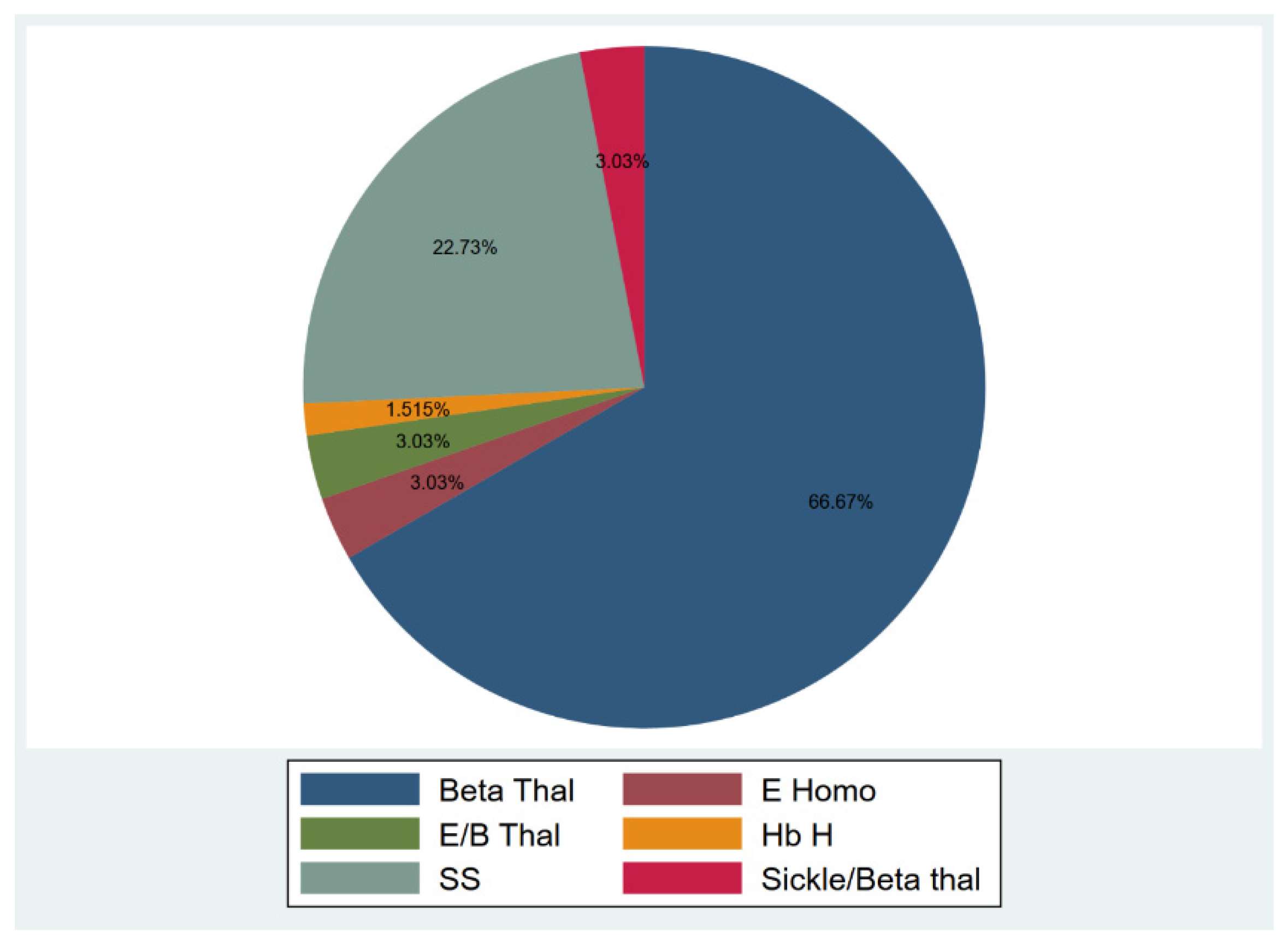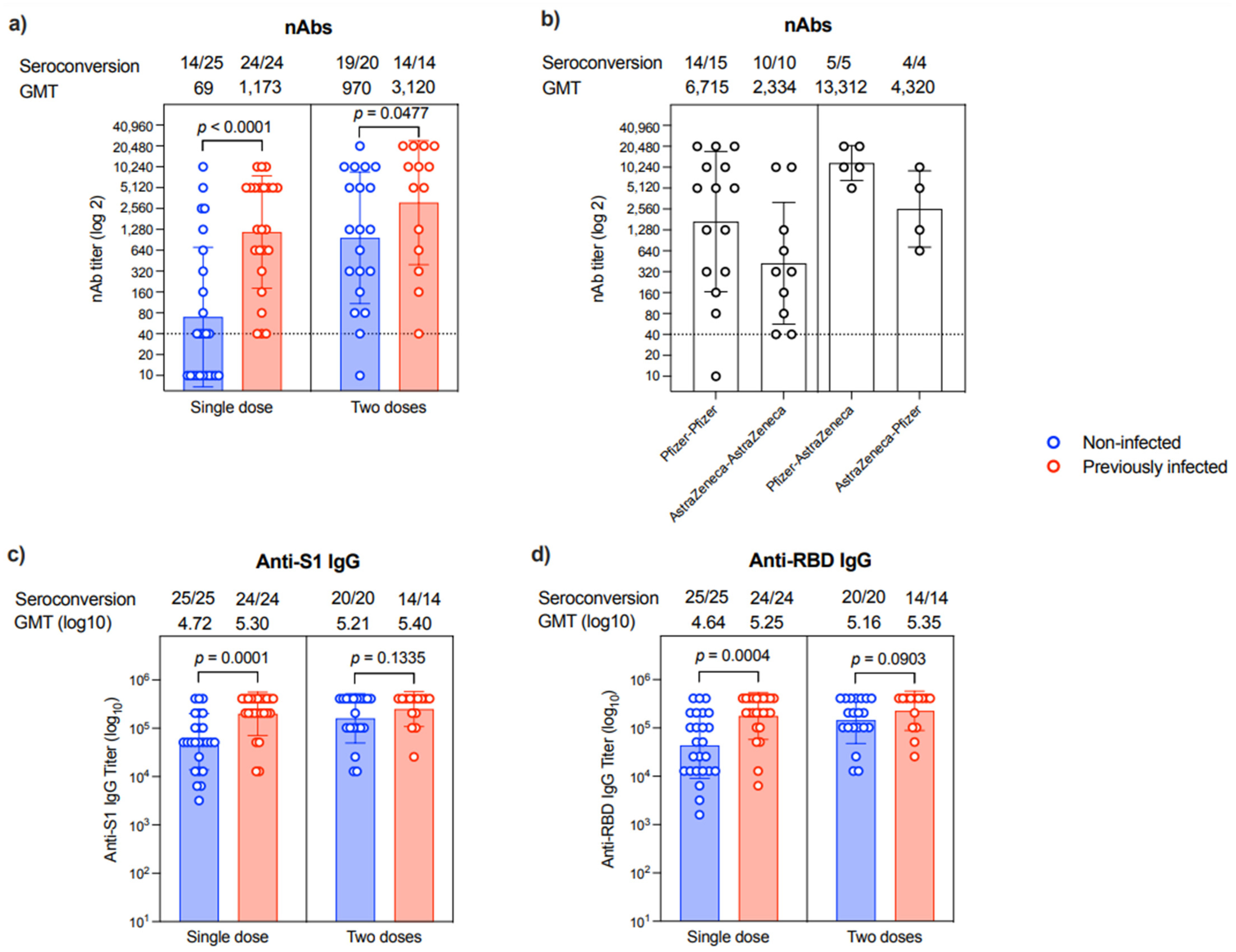Immunogenicity of The BNT162b2 COVID-19 mRNA and ChAdOx1 nCoV-19 Vaccines in Patients with Hemoglobinopathies
Abstract
:1. Introduction
2. Materials and Methods
2.1. Clinical Samples
2.2. Laboratory Testing
2.3. Statistical Analysis
3. Results
4. Discussion
5. Limitations
6. Conclusions
Supplementary Materials
Author Contributions
Funding
Institutional Review Board Statement
Informed Consent Statement
Data Availability Statement
Acknowledgments
Conflicts of Interest
Ethics Approval Statement
References
- WHO Coronavirus (COVID-19) Dashboard. Available online: https://covid19.who.int (accessed on 1 December 2021).
- Forni, G.; Mantovani, A. COVID-19 vaccines: Where we stand and challenges ahead. Cell Death Differ. 2021, 28, 626–639. [Google Scholar] [CrossRef]
- COVID-19 & Vaccine FAQs from Ministry of Health—Kingdom of Saudi Arabia. Available online: https://www.moh.gov.sa/en/Ministry/HotTopics/Pages/COVID-19-Vaccine.aspx (accessed on 1 December 2021).
- Voysey, M.; Clemens, S.A.C.; Madhi, S.A.; Weckx, L.Y.; Folegatti, P.M.; Aley, P.K.; Angus, B.; Baillie, V.L.; Barnabas, S.L.; Bhorat, Q.E.; et al. Safety and efficacy of the ChAdOx1 nCoV-19 vaccine (AZD1222) against SARS-CoV-2: An interim analysis of four randomized controlled trials in Brazil, South Africa, and the UK. Lancet 2021, 397, 99–111. [Google Scholar] [CrossRef]
- Polack, F.P.; Thomas, S.J.; Kitchin, N.; Absalon, J.; Gurtman, A.; Lockhart, S.; Perez, J.L.; Marc, G.P.; Moreira, E.D.; Zerbini, C.; et al. Safety and Efficacy of the BNT162b2 mRNA COVID-19 Vaccine. N. Engl. J. Med. 2020, 383, 2603–2615. [Google Scholar] [CrossRef]
- Krammer, F.; Srivastava, K.; Ashlammary, H.; Amoako, A.A.; Awawda, M.H.; Beach, K.F.; Bermudez-Gonzalez, M.C.; Bielak, D.A.; Carreno, J.M.; Chernet, R.L.; et al. Antibody Responses in Seropositive Persons after a Single Dose of SARS-CoV-2 mRNA Vaccine. N. Engl. J. Med. 2021, 384, 1372–1374. [Google Scholar] [CrossRef] [PubMed]
- Vij, R.; Machado, R.F. Pulmonary complications of hemoglobinopathies. Chest 2010, 138, 973–983. [Google Scholar] [CrossRef] [PubMed]
- Lee, J.X.; Chieng, W.K.; Lau, S.C.D.; Tan, C.E. COVID-19 and Hemoglobinopathies: A Systematic Review of Clinical Presentations, Investigations, and Outcomes. Front. Med. 2021, 8, 757510. [Google Scholar] [CrossRef] [PubMed]
- Taher, A.T.; Bou-Fakhredin, R.; Kreidieh, F.; Motta, I.; De Franceschi, L.; Cappellini, M.D. Care of patients with hemoglobin disorders during the COVID-19 pandemic: An overview of recommendations. Am. J. Hematol. 2020, 95, E208–E210. [Google Scholar] [CrossRef] [PubMed]
- Hoogenboom, W.S.; Alamuri, T.T.; McMahon, D.M.; Balanchivadze, N.; Dabak, V.; Mitchell, W.B.; Morrone, K.B.; Manwani, D.; Duong, T.Q. Clinical outcomes of COVID-19 in patients with sickle cell disease and sickle cell trait: A critical appraisal of the literature. Blood Rev. 2021, 100911. [Google Scholar] [CrossRef]
- Mbaeyi, S.; Oliver, S.E.; Collins, J.P.; Godfrey, M.; Goswami, N.D.; Hadler, S.C.; Jones, J.; Moline, H.; Moulia, D.; Reddy, S.; et al. The Advisory Committee on Immunization Practices’ Interim Recommendations for Additional Primary and Booster Doses of COVID-19 Vaccines—The United States, 2021. MMWR Morb. Mortal. Wkly. Rep. 2021, 70, 1545–1552. [Google Scholar] [CrossRef]
- Farmakis, D.; Giakoumis, A.; Cannon, L.; Angastiniotis, M.; Eleftheriou, A. COVID-19, and thalassemia: A position statement of the Thalassaemia International Federation. Eur. J. Haematol. 2020, 105, 378–386. [Google Scholar] [CrossRef]
- Telfer, P.; De la Fuente, J.; Sohal, M.; Brown, R.; Eleftheriou, P.; Roy, N.; Piel, F.B.; Chakravorty, S.; Gardner, K.; Velangi, M.; et al. Real-time national survey of COVID-19 in hemoglobinopathy and rare inherited anemia patients. Haematologica 2020, 105, 2651–2654. [Google Scholar] [CrossRef] [PubMed]
- Algaissi, A.; Alfaleh, M.A.; Hala, S.; Abujamel, T.S.; Almari, S.S.; Almahboub, S.A.; Alluhaybi, K.A.; Hobani, K.I.; Alsulaiman, R.M. AlHarbi, R.H.; et al. SARS-CoV-2 S1 and N-based serological assays reveal rapid seroconversion and induction of specific antibody response in COVID-19 patients. Sci. Rep. 2020, 10, 16561. [Google Scholar] [CrossRef]
- Almahboub, S.A.; Algaissi, A.; AlFaleh, M.A.; ElAssouli, M.-Z.; Hashem, A.M. Evaluation of Neutralizing Antibodies Against Highly Pathogenic Coronaviruses: A Detailed Protocol for a Rapid Evaluation of Neutralizing Antibodies Using Vesicular Stomatitis Virus Pseudovirus-Based Assay. Front. Microbiol. 2020, 11, 2020. [Google Scholar] [CrossRef] [PubMed]
- Alhabbab, R.Y.; Alsaieedi, A.; Algaissi, A.; Almahboub, S.; Al-Raddadi, R.M.; Shabouni, O.I.; Alhabbab, R.; Alfaraj, A.A.; Alamri, S.S.; Aljehani, N.D.; et al. Seroprevalence of SARS-CoV-2 Binding and Neutralizing Antibodies in Healthcare Workers during the Epidemic Peak in Referral Hospitals and Quarantine Sites: Saudi Arabia. Viruses 2021, 13, 1413. [Google Scholar] [CrossRef]
- Barefah, A.S.; Radhwi, O.O.; Alamri, S.S.; Alahwal, H.M.; Denetiu, I.; Almohammadi, A.T.; Bahashwan, S.M.; Qari, M.H.; Algaissi, A.; Alamer, E.; et al. Low clinical utility of testing for anti-platelet factor 4 in asymptomatic individuals after ChAdOx1 nCoV-19 vaccine. Int. J. Lab. Hematol. 2021, 1–6. [Google Scholar] [CrossRef]
- Alhamlan, F.; Al-Qahtani, A.; Obeid, D.; Aljumaah, S.; Alghamdi, S.; Alnafee, K.; Alsanea, M.; Alahideb, B.; Almutairi, S.; Alsuwairi, F.; et al. SARS-CoV-2 Delta Variant Predominant at a Tertiary-Care Hospital in Saudi Arabia. Research Square, 2021. Available online: https://assets.researchsquare.com/files/rs-779549/v1/62172fc7-b073-47b0-8ae8-25c5913e96bf.pdf?c=1631887677 (accessed on 26 December 2021).
- Prendecki, M.; Clarke, C.; Brown, J.; Cox, A.; Gleeson, S.; Guckian, M.; Randell, P.; Pria, A.D.; Lightstone, L.; Xu, X.-N.; et al. Effect of previous SARS-CoV-2 infection on humoral and T-cell responses to single-dose BNT162b2 vaccine. Lancet 2021, 397, 1178–1181. [Google Scholar] [CrossRef]
- Bradley, T.; Grundberg, E.; Selvarangan, R.; LeMaster, C.; Fraley, E.; Banerjee, D.; Belden, B.; Louiselle, D.; Nolte, N.; Biswell, R.; et al. Antibody Responses after a Single Dose of SARS-CoV-2 mRNA Vaccine. N. Engl. J. Med. 2021, 384, 1959–1961. [Google Scholar] [CrossRef]
- Interim Guidelines for the Use of SARS-CoV-2 Vaccine by the Saudi Public Health Authority. Published 31 August 2021. Available online: https://covid19.cdc.gov.sa/professionals-health-workers/interim-guidelines-for-the-use-of-sars-cov-2-vaccine (accessed on 13 January 2022).
- Updated Guidance on Booster COVID-19 Vaccine Doses in Canada by the National Advisory Committee on Immunization (NACI). Published 3 December 2021. Available online: https://www.canada.ca/en/public-health/services/immunization/national-advisory-committee-on-immunization-naci/guidance-booster-covid-19-vaccine-doses.html (accessed on 13 January 2022).
- Hillus, D.; Schwarz, T.; Tober-Lau, P.; Vanshylla, K.; Hastor, H.; Thibeault, C.; Jentzsch, S.; Helbig, E.T.; Lippert, L.J.; Tscheak, P.; et al. Safety, reactogenicity, and immunogenicity of homologous and heterologous prime-boost immunisation with ChAdOx1 nCoV-19 and BNT162b2: A prospective cohort study. Lancet Respir. Med. 2021, 9, 1255–1265. [Google Scholar] [CrossRef]
- Stuart, A.S.V.; Robert, H.S.; Liu, X.; Greenland, M.; Aley, P.K.; Andrews, N.J.; Cameron, J.C.; Charlton, S.; Clutterbuck, E.A.; Collins, A.M.; et al. Immunogenicity, safety, and reactogenicity of heterologous COVID-19 primary vaccination incorporating mRNA, viral-vector, and protein-adjuvant vaccines in the UK (Com-COV2): A single-blind, randomised, phase 2, non-inferiority trial. Lancet 2022, 399, 36–49. [Google Scholar] [CrossRef]
- Taher, A.T.; Musallam, K.M.; Cappellini, M.D. β-Thalassemias. N. Engl. J. Med. 2021, 384, 727–743. [Google Scholar] [CrossRef] [PubMed]
- Hankins, J.S.; Ware, R.E.; Rogers, Z.R.; Wynn, L.W.; Lane, P.A.; Scott, J.P.; Wang, W.C. Long-term hydroxyurea therapy for infants with sickle cell anemia: The HUSOFT extension study. Blood 2005, 106, 2269–2275. [Google Scholar] [CrossRef] [PubMed] [Green Version]
- Steinberg, M.H.; Barton, F.; Castro, O.; Pegelow, C.H.; Ballas, S.K.; Kutlar, A.; Orringer, E.; Bellevue, R.; Olivieri, N.; Eckman, J.; et al. Effect of hydroxyurea on mortality and morbidity in adult sickle cell anemia: Risks and benefits up to 9 years of treatment. JAMA 2003, 289, 1645–1651. [Google Scholar] [CrossRef]
- Ansari, S.H.; Lassi, Z.S.; Khowaja, S.M.; Adil, S.O.; Shamsi, T.S. Hydroxyurea (hydroxycarbamide) for transfusion-dependent β-thalassaemia. Cochrane Database Syst. Rev. 2019, 3, CD012064. [Google Scholar] [CrossRef]
- Lederman, H.M.; Connolly, M.A.; Kalpatthi, R.; Ware, R.E.; Wang, W.C.; Luchtman-Jones, L.; Waclawiw, M.; Goldsmith, J.C.; Swift, A.; Casella, J.F.; et al. Immunologic effects of hydroxyurea in sickle cell anemia. Pediatrics 2014, 134, 686–695. [Google Scholar] [CrossRef] [Green Version]
- Koehl, B.; Aupiais, C.; Schinckel, N.; Mornand, P.; Odièvre, M.-H.; Niakate, A.; Brousse, V.; Ithier, G.; Missud, F.; Holvoet, L.; et al. Tolerance and humoral immune response to the yellow fever vaccine in sickle cell disease children treated with hydroxyurea: A multicentre prospective study. J. Travel Med. 2021, 28, taab013. [Google Scholar] [CrossRef] [PubMed]
- Mucalo, L.; Brandow, A.M.; Dasgupta, M.; Mason, S.F.; Simpson, P.M.; Singh, A.; Taylor, B.W.; Woods, K.J.; Yusuf, F.I.; Panepinto, J.A. Comorbidities are risk factors for hospitalization and serious COVID-19 illness in children and adults with sickle cell disease. Blood Adv. 2021, 5, 2717–2724. [Google Scholar] [CrossRef]
- Kozak, K.E.; Ouyang, L.; Derkach, A.; Sherman, A.; McCall, S.; Famulare, C.; Chervin, J.; Daley, R.J.; Morjaria, S.; Mauro, M.; et al. Serum antibody response in patients with philadelphia-chromosome positive or negative myeloproliferative neoplasms following vaccination with SARS-CoV-2 spike protein messenger RNA (mRNA) vaccines. Leukemia 2021, 35, 3578–3580. [Google Scholar] [CrossRef]
- Trafane, L.F.; da Costa, V.A.; da Silva Santos Duarte, A.; Zangirolami, A.B.; Proenca-Modena, J.L.; de Melo Campos, P.; de Souza Medina, S.; Saad, S.; Addas-Carvalho, M.; Benites, B.D. Low SARS-CoV-2 seroprevalence in a cohort of Brazilian sickle cell disease patients: Possible effects of emphasis on social isolation for a population initially considered to be at very high risk. EJHaem 2021, 2, 478–482. [Google Scholar] [CrossRef]



| Characteristic | Category | Total n = 66 (%) | Seropositive n = 56 (%) | Seronegative n = 10 (%) | p Value |
|---|---|---|---|---|---|
| Gender a | Male | 27 (41) | 23 (41.1) | 4 (40) | 1.0 |
| Female | 39 (59) | 33 (58.9) | 6 (60) | ||
| Age b | 31 (18–49) | 33.7 (21–53) | 0.34 | ||
| No. of doses a | One | 32 (48) | 23 (41.1) | 9 (90) | 0.005 |
| Two | 34 (52) | 33 (58.9) | 1 (10) | ||
| Hemoglobinopathy a | TDT | 51 (77) | 43 (76.8) | 8 (80) | 1.0 |
| SCD | 15 (23) | 13 (23.2) | 2 (20) | ||
| Splenectomy a | Yes | 31 (47) | 25 (44.6) | 6 (60) | 0.5 |
| No | 35 (53) | 31 (55.4) | 4 (40) | ||
| Hydroxyurea a | Yes | 17 (26) | 15 (26.8) | 2 (20) | 1.0 |
| No | 49 (74) | 41 (73.2) | 8 (80) | ||
| Hyperferritinemia (>1000 μg/mL) a | Yes | 54 (82) | 45 (80.4) | 9 (90) | 0.7 |
| No | 12 (18) | 11 (19.6) | 1 (10) | ||
| History of COVID-19 a; Anti-N positive | Yes | 31 (47) | 31 (55.4) | 0 (0) | 0.001 |
| No | 35 (53) | 25 (44.6) | 10 (100) |
Publisher’s Note: MDPI stays neutral with regard to jurisdictional claims in published maps and institutional affiliations. |
© 2022 by the authors. Licensee MDPI, Basel, Switzerland. This article is an open access article distributed under the terms and conditions of the Creative Commons Attribution (CC BY) license (https://creativecommons.org/licenses/by/4.0/).
Share and Cite
Radhwi, O.O.; Jan, H.; Waheeb, A.; Alamri, S.S.; Alahwal, H.M.; Denetiu, I.; Almanzlawey, A.; Al-Marzouki, A.F.; Almohammadi, A.T.; Bahashwan, S.M.; et al. Immunogenicity of The BNT162b2 COVID-19 mRNA and ChAdOx1 nCoV-19 Vaccines in Patients with Hemoglobinopathies. Vaccines 2022, 10, 151. https://doi.org/10.3390/vaccines10020151
Radhwi OO, Jan H, Waheeb A, Alamri SS, Alahwal HM, Denetiu I, Almanzlawey A, Al-Marzouki AF, Almohammadi AT, Bahashwan SM, et al. Immunogenicity of The BNT162b2 COVID-19 mRNA and ChAdOx1 nCoV-19 Vaccines in Patients with Hemoglobinopathies. Vaccines. 2022; 10(2):151. https://doi.org/10.3390/vaccines10020151
Chicago/Turabian StyleRadhwi, Osman O., Hamza Jan, Abdullah Waheeb, Sawsan S. Alamri, Hatem M. Alahwal, Iuliana Denetiu, Ashgan Almanzlawey, Adel F. Al-Marzouki, Abdullah T. Almohammadi, Salem M. Bahashwan, and et al. 2022. "Immunogenicity of The BNT162b2 COVID-19 mRNA and ChAdOx1 nCoV-19 Vaccines in Patients with Hemoglobinopathies" Vaccines 10, no. 2: 151. https://doi.org/10.3390/vaccines10020151
APA StyleRadhwi, O. O., Jan, H., Waheeb, A., Alamri, S. S., Alahwal, H. M., Denetiu, I., Almanzlawey, A., Al-Marzouki, A. F., Almohammadi, A. T., Bahashwan, S. M., Barefah, A. S., Qari, M. H., Abuzenadah, A. M., & Hashem, A. M. (2022). Immunogenicity of The BNT162b2 COVID-19 mRNA and ChAdOx1 nCoV-19 Vaccines in Patients with Hemoglobinopathies. Vaccines, 10(2), 151. https://doi.org/10.3390/vaccines10020151






